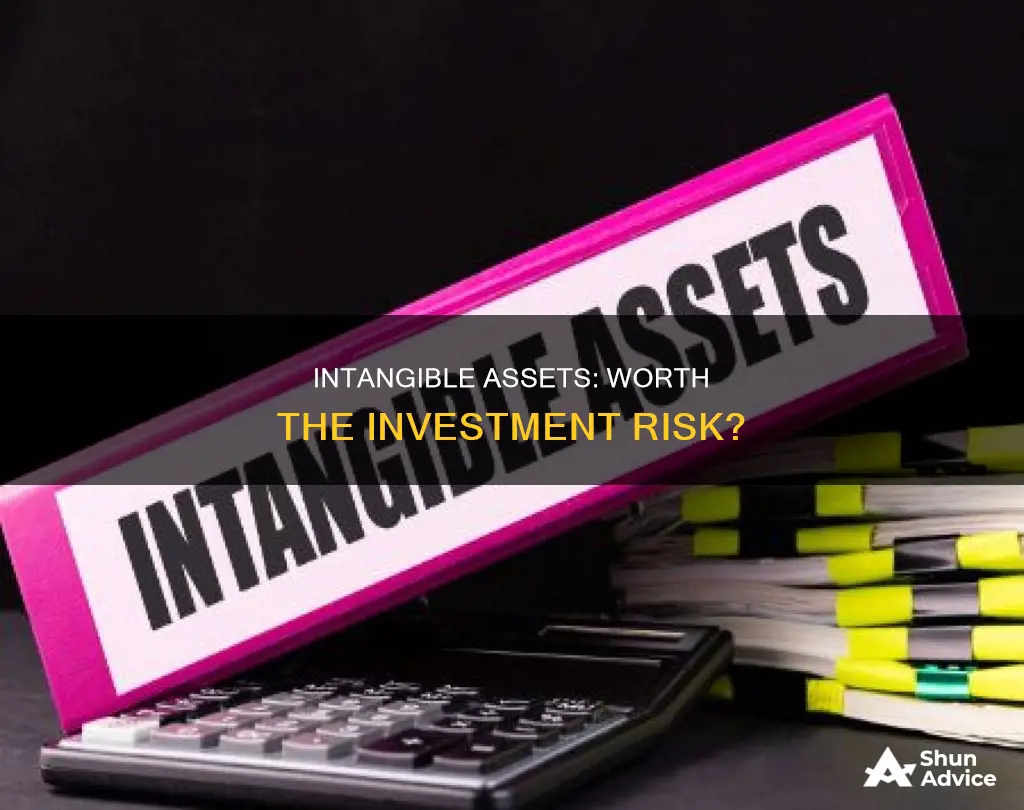
Intangible assets are non-physical assets that provide value to a business. Examples include patents, trademarks, copyrights, and brand recognition. They are often critical to a company's long-term success and can be difficult to value due to their non-physical nature. Companies that invest heavily in intangibles are more likely to outperform their peers and achieve higher growth rates. This is because intangibles such as intellectual property, research, technology, and software can give a company a competitive advantage in the market. However, it is important to note that investing in intangibles is different from investing in tangible assets, and it requires a mindset shift towards a test-and-learn, risk-taking approach.
| Characteristics | Values |
|---|---|
| Intangible assets are critical to a company's long-term success | Brand recognition, customer loyalty, patents, copyrights, trademarks, talent retention |
| Intangible assets are difficult to value | No recorded book value, future benefits and lifespan uncertain, limited public data |
| Intangible assets can be categorised as definite or indefinite | Definite: copyrights, patents; Indefinite: brand names |
| Intangible assets are harder to quantify and more volatile than tangible assets | Harder to transfer ownership, less stable value due to no societal demand |
| Intangible assets are key to a company's competitive advantage | Innovation, knowledge, intellectual property, brand recognition, talent retention |
What You'll Learn
- Intangible assets are harder to value but can be critical to a company's long-term success
- Intangible assets are non-physical and include intellectual property, patents, and brand recognition
- Intangible assets can be categorised as either definite or indefinite
- Intangible assets are harder to transfer, protect and store than tangible assets
- Intangible assets can be valued using the market, cost or income approach

Intangible assets are harder to value but can be critical to a company's long-term success
Intangible assets are harder to value than their tangible counterparts, but they can be critical to a company's long-term success.
Intangible assets are non-physical assets that provide value to a company over the long term. They include things like patents, trademarks, copyrights, brand recognition, and research and development (R&D). These assets are often key drivers of shareholder value, especially in the knowledge economy.
The value of intangible assets can be challenging to determine due to their non-physical nature and the various formulas used to calculate their worth. Additionally, intangible assets may have an indefinite or definite lifespan, further complicating their valuation. Indefinite intangible assets, such as brand names, remain with the company as long as it is in business, while definite intangible assets, like copyrights and patents, have a specified expiration date.
Despite the challenges in valuation, intangible assets play a vital role in a company's success and survival. In today's economy, driven by innovation and knowledge, companies that invest heavily in intangibles are reinforcing their competitive advantage and achieving higher growth rates. For example, companies in the top quartile for growth in gross value-added invest 2.6 times more in intangibles than those in the bottom two quartiles.
Intangible assets contribute significantly to a company's overall value and future potential. They drive future growth and innovation, even though they are more challenging to quantify and are more volatile than tangible assets.
While tangible assets like buildings and machinery provide stability and can serve as collateral, intangible assets are essential for long-term success. They are harder to value, but they can be the differentiators that drive a company's growth and market position.
Mastering Investing.com's Technical Analysis Tools for Beginners
You may want to see also

Intangible assets are non-physical and include intellectual property, patents, and brand recognition
Intellectual property rights, such as patents, trademarks, designs, copyrights, and trade secrets, are all examples of intangible assets. These assets provide legal protection and allow companies to innovate and protect their ideas and inventions from unauthorized use or implementation.
Brand recognition, another form of intangible asset, refers to the reputation a company builds over time. It is a powerful tool that contributes to increased sales and customer loyalty. Customers are more likely to choose a familiar brand, even if it is not the best option. This demonstrates the value of brand recognition in driving a company's long-term success.
Intangible assets also include customer lists, domain names, legal rights and permits, licensing agreements, computer software, and goodwill. These assets have long-term value and contribute to a company's growth and success.
While intangible assets are challenging to value and monetize, they are essential for companies to create a competitive advantage and drive innovation. They represent the prospective value of a company and contribute to its overall value and future potential.
Fiscal Policy: Stimulating Investment with Tax Cuts
You may want to see also

Intangible assets can be categorised as either definite or indefinite
Intangible assets are non-physical assets that provide value to a company. They are the opposite of tangible assets, which have transactional exchange value. Intangible assets are often critical to a company's long-term success and can be categorised as either definite or indefinite.
Definite intangible assets are those with a foreseeable end to their value. They are restricted to a limited timeframe. For example, a legal agreement to operate under another company's patent. Other examples include copyrights and patents, which are only valuable until their expiry date.
Indefinite intangible assets, on the other hand, will stay with the business as long as it exists. These assets are critical to a company's brand and reputation and include items such as brand names, trademarks, and logos. Indefinite intangible assets are not amortised as they will continue to provide value over time.
It is important to note that while intangible assets are valuable, they are not always easy to value. Their non-physical nature makes it challenging to assign a specific number or calculate their worth. However, intangible assets are increasingly critical to a company's overall value and future potential, making them an essential aspect for investors to consider when evaluating a company.
Recession-Proof Cash Investments: Where to Park Your Money
You may want to see also

Intangible assets are harder to transfer, protect and store than tangible assets
Intangible assets are harder to transfer, protect, and store than tangible assets. This is because they are non-physical assets that are often rooted in intellectual property. They are conceptual in nature and cannot be physically touched, seen, or modified. They are also harder to quantify and are more volatile.
Intangible assets are typically transferred through acquisition, where one company is purchased by another. In this case, the value of the intangible assets of the target company, such as brand recognition and goodwill, may be difficult to accurately assess and may be lost if not properly capitalised on by the acquiring company. This makes the transfer of intangible assets a complex and risky process.
Protecting intangible assets can also be challenging due to their non-physical nature. While tangible assets can be protected through physical security measures and insurance, intangible assets are often protected through legal means such as patents, trademarks, and copyrights. Enforcing these legal protections can be difficult and may require costly litigation. Additionally, intangible assets are susceptible to risks such as obsolescence, infringement, and changes in market conditions, which can be hard to guard against.
Storing intangible assets can be difficult as they often have no physical presence. While tangible assets can be stored in a physical location, intangible assets may require digital storage, which can be vulnerable to cyber-attacks and data loss. Additionally, the storage of intangible assets may require continuous investment in research and development to maintain their value over time.
Overall, intangible assets pose unique challenges when it comes to transfer, protection, and storage due to their non-physical and conceptual nature. These assets are crucial for companies' future growth and innovation and require careful management to maintain their value.
Robinhood Brokerage Cash: Investing Strategies for Beginners
You may want to see also

Intangible assets can be valued using the market, cost or income approach
Intangible assets are increasingly important to a company's value, but they are difficult to capture in financial statements due to current accounting standards. This has led to the development of new valuation methods that build on historical and prospective financial information. Five of the more common valuation methods that are within the framework of the cost, market, and income approach are:
- Relief from Royalty Method (RRM): This method calculates value based on hypothetical royalty payments saved by owning the asset instead of licensing it. It involves projecting financial information, estimating a royalty rate, useful life of the asset, and discount rate, and applying these to estimate revenue streams.
- Multiperiod Excess Earnings Method (MPEEM): A variation of discounted cash flow analysis, MPEEM isolates the cash flows associated with a single intangible asset and discounts them to present value. It involves projecting financial information, subtracting cash flows attributable to other assets, and calculating the cash flows attributable to the intangible asset.
- With and Without Method (WWM): This method estimates the value of an intangible asset by calculating the difference between two discounted cash flow models: one with the asset in place and one without it.
- Real Option Pricing: This method is suitable for valuing intangible assets that have the potential to create cash flows in the future but do not currently. It uses an option pricing model to capture the "time value" component of an asset that is not currently generating cash flows.
- Replacement Cost Method Less Obsolescence: This method assesses the replacement cost for an intangible asset and adjusts it for obsolescence. It considers the tax impact of the asset's amortization and the obsolescence percentage, which is often developed through consultation with technical management personnel.
These approaches can be integrated with an analysis of non-GAAP KPIs and other conceptual frameworks to capture the value provided by intangible assets in enterprise valuation.
Investing vs. Saving: Where Should Your Cash Go?
You may want to see also
Frequently asked questions
Intangible assets are non-physical assets that hold long-term value for a business. Examples include patents, brand names, trademarks, copyrights, and research and development.
Intangible assets are critical to a company's long-term success and can give a company a competitive edge over its rivals. Companies that invest most heavily in intangibles are reinforcing and deepening their competitive advantage and achieving the highest rates of growth in gross value added.
There is no standardised formula for valuing intangible assets. However, there are three basic approaches: the market approach, the cost approach, and the income approach.
Intangible assets can be difficult to value due to their non-physical nature and the various formulas used to calculate their value. They are also harder to quantify and more volatile than tangible assets.







